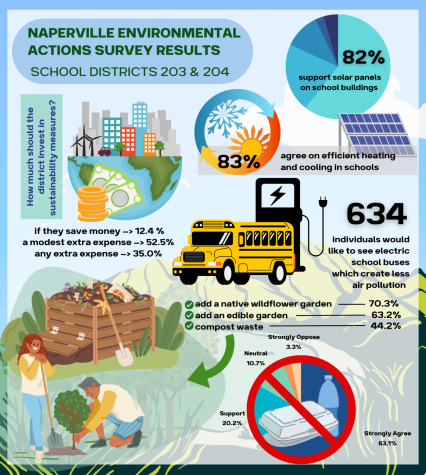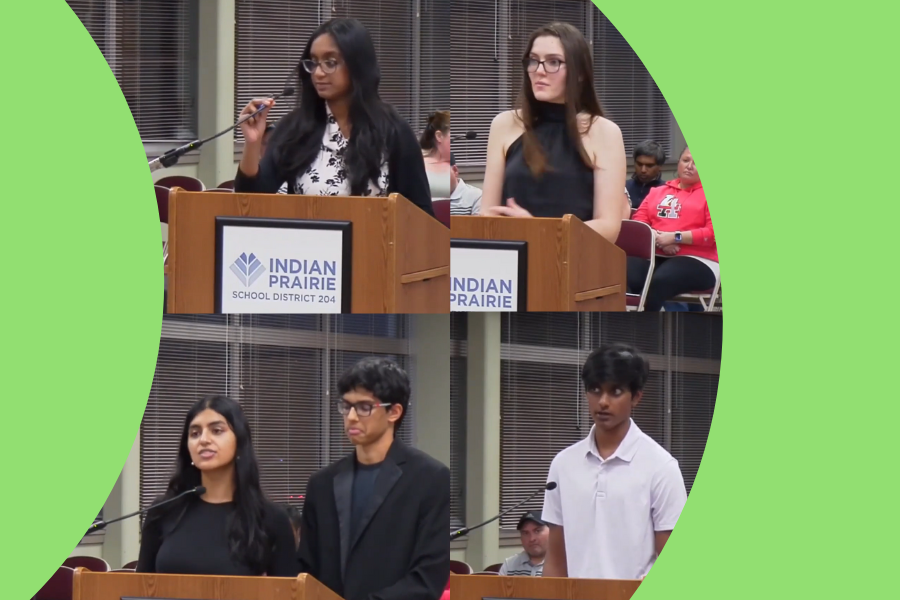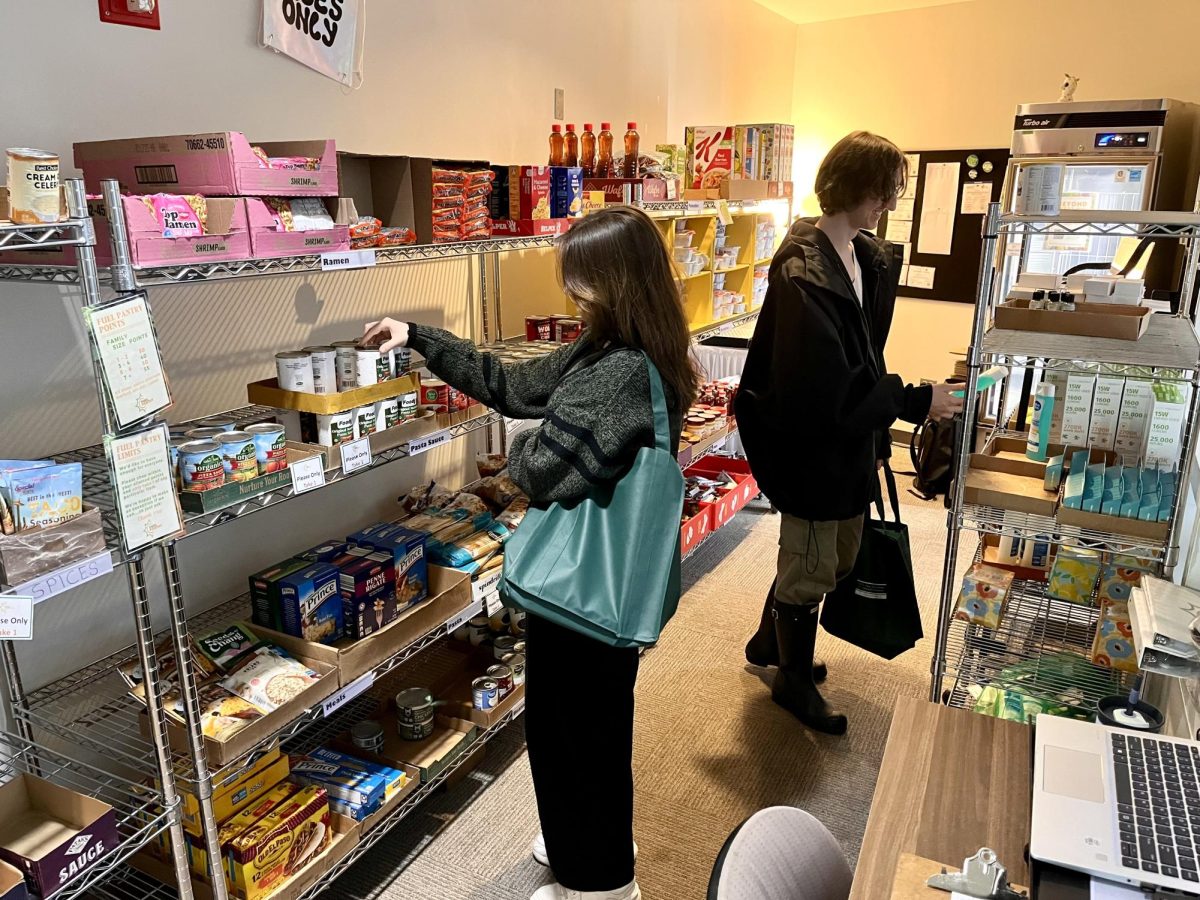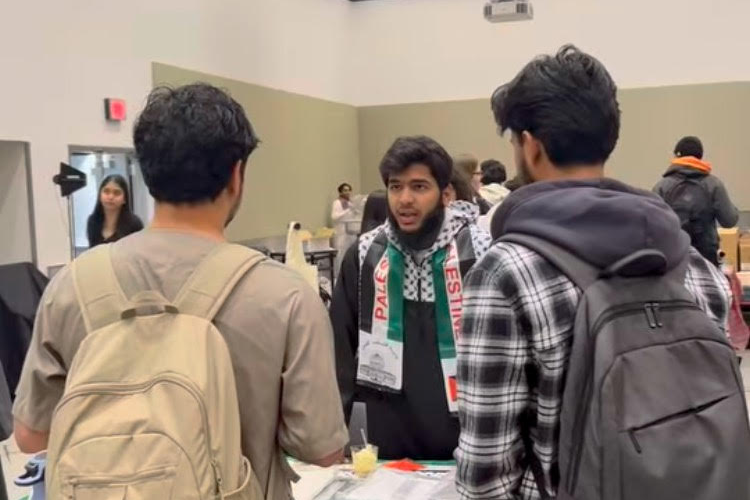Teen Activists Urge Eco-Friendly Changes in Naperville and Aurora Schools
Five high schoolers spoke to the Naperville-Aurora District 204 school board about implementing sustainable actions in school, with support from almost 1,100 respondents of a community survey.
May 1, 2023
In many communities, teenagers lead the struggle for environmental changes. This holds true for five high schoolers from Naperville and Aurora who took to the podium to address the Indian Prairie School District 204 on April 10. They shared the findings of a survey they created to gauge community support for sustainable changes that can be made in their schools.
These young environmentalists are part of the Naperville Environment and Sustainability Task Force’s Youth Team, working with the guidance of NEST Chairwoman Cathy Clarkin. In the first three months of 2023, the task force’s Youth Team administered the survey through Google Forms to people across Naperville and Aurora.
It had 10 questions proposing changes such as strengthening recycling programs in schools, composting food waste from lunches, planting edible gardens, adding solar panels, electric school buses and energy-efficient heating and cooling systems in schools. The survey received 1,093 responses from students, as well as parents, teachers, faculty and community residents.

Riley Leu, a senior at Metea Valley High School, is a leader of the Youth Team. She has worked with them for years to lead environmental projects, like forest preserve stewardships. Leu earned the Youth Service award at the KidsMatter Awards for her work in 2022. She discussed how this year’s focus has been the sustainable schools survey.
“In total, we had approximately 1,100 respondents and found widespread support for these initiatives,” Leu said. “The results show that approximately 83% of respondents thought that even if these measures cost the district a little bit of money, it would be worth the return to reduce greenhouse emissions in [District] 204 buildings.”
The Youth Team compiled the results of their survey, with percentages and data graphs to illustrate the community responses, and they presented this report to the School District 204 members.
“We encourage you to act on the findings of this survey, because of not only the economic benefit and current support, but because of how it will affect future generations,” Leu concluded. “Climate change is a current issue that we are already starting to feel some of the effects, and we will continue to see within this generation.”
Vani Ramesh, a senior at Neuqua Valley High School, is also an active member of the NEST Youth Team. She founded the environmental action app, Natra, in the spring of 2022. She designed and coded the software herself, with the help of some high school classmates. They encourage people to adopt sustainable alternatives for small habits in their everyday lives.
Ramesh made comments about the importance of energy-efficient heating and cooling systems in the Indian Prairie School board meeting in early April.
“Being in a city where we experience weather of all types from hailstorms, super hot summers, and wind chills down to negative 40 degrees, climate control in high-use buildings, like schools, is incredibly important and incredibly costly,” Ramesh said. “It’s imperative we tackle this issue.”
She also emphasized that the sustainable school survey showed 82% of people who took the survey strongly supported energy-efficient heating and cooling being installed in schools. Ramesh also mentioned how 41% of U.S. school districts spend more than $2 billion annually, running outdated and fossil fuel-dependent heating and cooling systems.
In addition to shifting away from fossil fuel, the Youth Team survey proposed solar panel installation. Vallabh Arun, a sophomore at Waubonsie Valley High School and NEST Youth Team leader, spoke about the benefits of solar power, such as reduced emissions, lower electricity bills and cleaner air.
“As a student in this district, I want to help with taking action to preserve our schools and communities for years to come,” Arun stated. “These benefits of solar panels are actually seen in practice in numerous school districts across the nation, such as the Tucson Unified School District. In just 20 years, the district is estimated to have saved $43 million and reduced carbon emissions by 40 million pounds a year.”
Some of these sustainable initiatives have been applied in Illinois neighborhoods through the Green Ribbon Schools program. Based on the actions of Green Schools, students hope to strengthen already existing programs to make environmental changes. One of the most popular green initiatives in schools is to reduce, reuse, and recycle. Students who responded to the Youth Team’s survey expressed concern over the way non-recyclable materials are mixed into the recycling bins.
One Naperville Central student wrote, “Kids throw trash in the blue bins, and I’m not sure that what DOES get put into the bins goes to recycling. There could be more education on the how and why of recycling.”
A few of the survey’s sustainable suggestions are centered on school lunch rooms that produce copious amounts of waste. Remedies for this are to replace plastic and Styrofoam utensils with reusable or decomposable ones. The Youth Team also suggested creating a compost bin for food waste. Among the more controversial suggestions was a share table, where students can give away their unwanted lunch food items. Survey respondents worried about allergies, expired food and germs being exchanged, but hoped that an organized and sanitary system for the share table could help.
Survey participants also made critiques regarding the electric school buses. A Naperville Central student commented, “I don’t think the electric school buses will really help the environment as long as Illinois is getting its power from Prairie State and sourcing electricity from coal.” In response to these concerns, the Naperville Environment and Sustainability Task Force points to studies showing that electric vehicles still expend less energy to manufacture and fuel, compared to continued use of fossil fuel. Comparisons of clean fuel versus fossil fuel are made in the Energy section of the Sustainable Naperville 2036 report.
Laurie Donahue, president of the Indian Prairie School Board district, responded with appreciation in an email to the Youth Team.
“We are also proud of the team’s efforts to address environmental and sustainability needs,” Donahue said. “These are important topics for our district. We look forward to involving the NEST youth team in our facilities study. From a personal perspective, I have always considered myself an environmentalist. I drive my family crazy with my avoidance of plastic bags, recycling, composting, etc. I admire and appreciate your efforts.”
The question that remains is how funds will be gathered to implement these sustainable initiatives in a cost-effective way. One survey question asked, “Is it important for schools to reduce greenhouse gas emissions (the cause of climate change) and air pollution, even if it costs a bit more than the way things are normally done?”
In response, 554 people said that only a modest expense is worth it. Conversely, 370 people replied that these measures are so necessary that any extra expense is worth it. Another 131 people said to only take actions that will save money. Concern about the cost to the school district versus the environmental benefit led many respondents to say that these changes can be gradually made as funds and resources are available.
A parent of a former Waubonsie Valley student suggested, “Hire a sustainability manager and create a climate/sustainability plan with set targets for reducing emissions and integration into the curriculum. Provide on-going training for faculty & PTAs on sustainability initiatives. Create regular communications to the community about sustainability efforts.”
The Youth Team has taken the first important step by proposing these sustainable solutions and gauging community support. They will continue to consult with School District 203 and 204, as well as taxpayers of Naperville and Aurora. On the evening of May 1, other NEST Youth Team members and high schoolers will speak at the Naperville Community Unit School District 203 Board meeting.
To learn more about the work done by the Youth Team members and hear their individual comments at the school board meetings, visit the Naperville Environment and Sustainability Task Force YouTube channel.




















